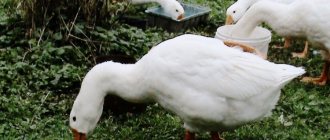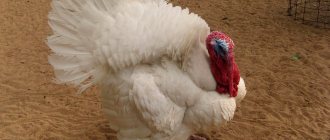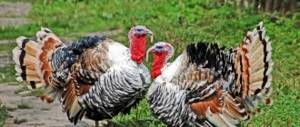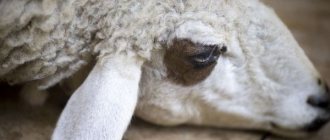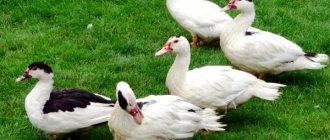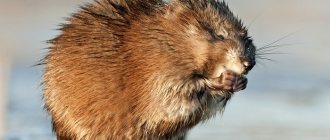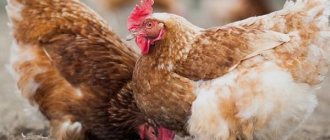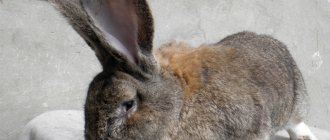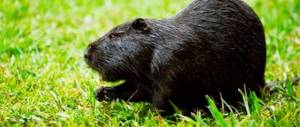Origin of the breed
This breed is classified as a fighting bird. It is believed that the Tula people appeared several centuries ago at the request of rich people who wanted to have fun watching bird fights. The strongest and most ardent “fighters” began to be selected for further breeding - and this is how this breed was developed.
Where the name of these geese came from and why they are “Tula” is not known for certain. There is an assumption that it was in Tula and its surrounding regions that goose fighting was widespread and enjoyed success.
Short description
Considering the specifics of the breed, these geese are called Tula fighting geese, and it is this name that has stuck among the people. Thanks to constant artificial selection, modern representatives of the breed differ in:
Thanks to the listed characteristics, the breed has become an ideal example of natural fighting characteristics. The appearance of Tula geese is impressive, since during the period of active breeding the appearance has become perfect. It should be noted that strength and endurance indicators are successfully combined with a small body weight, which has a developed muscular system, and is also characterized by high structural density.
Description and standards of Tula geese
Visually, Tuls are distinguished by their wide chest and strong build. The stable legs of these birds are spread wide, and strong and developed wings are pressed to the body. The head has a wide forehead and a massive but small beak. The neck of these birds is short and thick, and the eyes are steel or black.
The plumage of these birds can be gray, whitish or clayey. The latter have a light brown head and the same neck, chest and back. The belly of geese is whitish, and the tail is lighter than the rest of the body.
Gray Tula geese usually have a bluish or shiny black plumage. The tail of the birds is grayish, sometimes whitish, and the lower part of the bird’s body is white. Young ganders and geese have lighter plumage than adults.
When breeding these geese, poultry farmers ensure that they do not have the following defects inherent in this breed:
- red eye;
- beak and eyelids are orange;
- double fold in the abdominal area;
- hump on the back;
- twisted wings;
- crop just under the beak.
Gorky fighting geese
This breed can not only be trained for fighting, but also bred for eggs and meat.
Appearance and physique
These are quite peaceful and friendly birds; they get along well with geese of other breeds and with other birds on the farm. Despite their quiet nature and low quarrelsomeness, these birds are taken to participate in fights due to their very rapid weight gain. Plus, the bird is very mobile and active. However, you will have to work with pets, because they are not inherently cruel, like, for example, Tula geese, which we will return to studying later.
External distinctive features of the breed:
- body: wide, elongated, slightly upturned on the front side;
- back: broad-shouldered, slightly inclined towards the tail;
- tail: well formed, slightly curled;
- chest: powerful, rounded, upturned;
- belly: well formed, with a single or double fold;
- wings: medium size, tightly hug the sides of the body;
- head: medium size, with a small growth (tubercle) on the frontal part;
- eyes: small, dark brown or blue;
- beak: medium in length, straight, orange in color, under the beak there is a large so-called purse (pouch);
- neck: relatively long, strong, with a slight bend in the upper part;
- shins: well formed, slightly protruding;
- metatarsals: short, orange in color;
- cover of feathers: dense, the color is predominantly pure white, but can be light gray, piebald, dark gray or brownish.
Weights
Purebred Gorky geese gain weight very quickly - at 2 months of age, the average live weight of the bird is 3.5-3.8 kg. Individuals that are too small are considered defective. The strong body of an adult bird has an impressive weight: the live weight of a gander is 7-8 kg, and that of a goose is 6-7 kg.
Read also: Homemade do-it-yourself geese feeder for grass and hay
Egg production
Egg production averages 45-50 eggs per year. Some geese produce up to 60 eggs, and for this breed this number means high egg production. The standard egg weight is 150 grams. Shell color is white.
Fertility of eggs is 90%, hatchability of goslings is 70-80% of laid eggs; The survival rate of chicks is quite high (85-95%). Such indicators are achieved only when eggs are kept in an incubator, since females of the Gorky breed rarely become brood hens.
Varieties of geese by beak shape
Due to the presence of a hooked nose, Tula birds are often called “hump-nosed”. In addition, the shape of the beak of these birds can be different, which is why there are three subspecies:
- straight-nosed - a less common type of the Tula breed; such birds have a smooth beak, without a hump;
- lay-nosed (rogali) - the upper contour of the bird’s beak looks concave, and one-year-old individuals also have small horns near the beak;
- steep-nosed - the upper outlines of the beak are convex, which gives the impression that the beak and head of the goose are located at the same level.
Characteristic qualities: pros and cons of the Tula breed
The undoubted advantages of fighting geese include:
- strong immunity;
- endurance;
- unpretentiousness in food;
- simple content;
- delicious meat;
- the ability to organize “bloodless” bird fights (compared to rooster fights, goose slaughters look quite harmless).
For those who want to raise Tula geese, it is useful to know the disadvantages of this breed:
- slow weight gain - geese mature only in the 2nd year of their life;
- small body size;
- low level of egg laying;
- a warlike disposition, due to which it will be difficult for such geese to get along with other domestic inhabitants of the yard - males aged 4 years are considered especially dangerous.
Features of the Tula breed of fighting geese are presented in the following video:
Possible diseases and their treatment
Despite their strong immunity and cold resistance, Tula geese can suffer from infectious diseases. The bird gets sick if it is kept crowded or if it lives in a dirty, damp, dark room.
Prevention of infections is regular cleaning of the poultry house, especially replacing bedding and cleaning feeders and drinkers. Disinfection must be carried out at least 2 times a year.
With improper, irrational feeding, Tula geese are affected by diseases of the digestive tract and metabolism. To prevent them, you need to create a proper, balanced diet. Give wet mash, not dry, plenty of clean water.
For hypovitaminosis, add vitamin preparations to the regular food, which can be purchased at veterinary stores.
Purpose
Today, tulas are most often used as poultry, raised for slaughter for meat. But thrill-seekers even nowadays stage various shows, including bird fights. The fighting breed of geese is excellent for this purpose.
For food
The meat obtained from Tula geese is very tasty. It is tender, juicy, and at the same time, the fatty layers are distributed evenly throughout the entire bird carcass, which is important for gourmets who are going to enjoy the meat delicacy.
Use in battles
Those who want to have fun can use Tula geese to take part in bird fights. At the same time, looking at them is not as scary as looking at roosters, since geese fight without blood. And the support group can include both the owners themselves and the geese who are in full view of the fighting geese.
The fight between males occurs with the help of wings. It is with them that they can attack and defend against the enemy. It is allowed to capture the wing with the beak. At the same time, it is forbidden to bite the head and paws of another gander several times in a row. If this happens, the goose fighting using such methods is removed from the competition.
Males aged 3 to 6 years are considered the most aggressive and strongest - at this time their wing stroke is very strong. As a rule, ganders try to hit the junction of the enemy’s neck and body.
The fight time is usually from 20 to 40 minutes. The fight ends when one of the fighters surrenders, leaving the battlefield. The winner is the goose that survives and fights off resistance. Males with a high pain tolerance often win.
Code of Goose Fighting
With the revival of the tradition of goose fighting, a new code began to be developed.
Each goose must have its own nickname and before the start of the fight the leader announces it. All major victories of a given goose are pronounced. If the pedigree of a goose is kept, the merits of its parents are mentioned.
Next, two geese are released into the ring, and with their cry they call on the bird to fight. An ancient instinct begins to play when two males fight for the favor of a female. During a fight, birds are prohibited from hitting on the head, pecking in the eyes, or plucking paws. The judge is obliged to stop the fight and in case of repeated violations may even disqualify the bird.
The main techniques are carried out by fighting on the wings. It is allowed to pinch the wing with the beak. Typically a fight lasts from 40 to 60 minutes. Typically, one of the geese gives up and runs away. But if the opponents are equal, the battle often goes differently. Then the judges have to determine which bird is stronger. And the physically stronger bird does not always win. The fighting spirit of a fighter is of great importance.
Read also: Grass chopper for chickens: how to make a feed chopper with your own hands
At the end of the battle, the winner is rewarded. In former times, the defeated bird was simply allowed into the soup, but nowadays this is not accepted. Raising a fighting goose is not cheap.
A few words in defense of goose fighting. Geese are the only animals that do not fight until they bleed. It is important for their natural instinct to show the female that the goose is worthy of her. In principle, the fight itself does not go beyond the natural behavior of the goose and does not harm its health.
What conditions are required for maintenance?
These birds are not afraid of the cold and have strong immunity to diseases. However, it is necessary to take care of a warm roof over the birds’ heads and provide a spacious area for them to walk.
Observe the following conditions when keeping fighting geese:
- Let the geese out for walks every day - nearby meadows, wetlands or ravines are suitable for this purpose (start grazing the week-old chicks);
- if there are no natural pastures nearby, plant a variety of perennial grasses and grains in an artificially created area for walking;
- waterfowl need bodies of water, but if they are not nearby, place a small trough with water in the yard so that the geese have the opportunity to take water treatments;
- provide the birds with a warm room with an internal temperature of at least +10 degrees - place straw and peat bedding on the floor of the room (in summer, sprinkle the floor with sand or sawdust);
- in the fall, before laying the flooring, treat the floor of the poultry house with lime;
- change the bedding in the birds' feeding area once every 5 days and once every 10 days where they sleep;
- Build a separate goose house for the chicks - cover the wooden slats with mesh and cover them with roofing felt.
Calculate the yard area and room area based on the number of birds, as well as their age. Young birds need at least 1 sq. m for one goose, for 2-month-old juveniles - 5 sq. m. m, and for adult birds – 15 sq. m.
Nutrition: features, norms and diet
Fighting geese are undemanding when it comes to nutrition. During daily walks or swimming in ponds, birds can feed themselves by foraging for food. However, you also need to feed them at home.
Feeding features of Tula birds:
- feed the birds three times a day (in winter, reduce food intake to 2 times), change the water once a day;
- feed the birds with cereal crops - millet, corn, oats (young geese should receive about 100-150 g, and adult geese - 80 g);
- make up for the lack of vitamins in winter with wet mixtures of grated beets or carrots, cabbage leaves - give young geese 200 g of these products per day, for adults increase the daily norm to 500 g;
- add shells and chalk to the food (young goslings need 5 g per day, the norm gradually increases with age), table salt (1 g per day), as well as vitamins and minerals (20 g for young birds and 30 g for adult birds);
- if the birds are not released into the wild, feed them with wet mixtures, adding bone or fish meal (about 2 g for juveniles and 3 g for adults), feed the birds with fresh small fish and other foods that contain animal protein.
Be careful with wheat. Give it to birds in moderation, as an overdose of this product will lead to rapid obesity in geese and will also reduce the hatching rate of chicks. Do not feed geese rye and vetch.
Give the chicks boiled egg yolks and finely chopped young onions. Then gradually introduce grass, porridge made from wheat or corn flour with mashed potatoes into their diet.
What to feed adult birds
It doesn’t matter for what purpose you are breeding geese (for competition or for meat), in any case, the bird needs a complete diet containing a sufficient amount of proteins, vitamins and microelements.
Check out the most popular breeds of geese.
“Sports” nutrition differs from “fatten” nutrition in that it should not cause excessive obesity, so you should very carefully select all nutrients, focusing on the season of the year.
Spring Summer
With the arrival of summer, the issue of providing geese with all the vitamins they need is no longer as relevant as before, because when free-ranging in the pasture, birds can independently find many useful herbs for themselves.
In addition to growing greenery, the owner should feed his pets grain crops in the form of corn and oats.
It is better not to feed rye and vetch, and wheat should occupy only a small part of the diet, since it quickly causes geese to accumulate excess fat.
Birds that are not allowed to graze should occasionally add fish or bone meal to their wet mash, as well as fresh, finely chopped fish and other high-protein animal products.
One average goose (about 5-6 kg) should receive at least 200-300 g of grain.
Autumn winter
During this period, even with a normal diet of dry and wet food, the birds’ diet often lacks vitamins and other micronutrients, so when preparing mash it is so important to grate carrots, beets, cabbage leaves and other vegetables available in the cold season.
Also, there should always be clean water near the birds, and if necessary, you can add special vitamin compounds to it, which are sold in veterinary pharmacies.
Breeding Tula geese
Follow these recommendations when raising fighting geese:
- form goose families from the moment the birds are 8-10 months old - while choosing the healthiest geese, based on the calculation of 1 gander for 2-3 geese;
- maintain a temperature of about +20 degrees in the room during egg laying and provide access to fresh air;
- adult females begin laying eggs in the last days of winter, and young females begin laying eggs a little later, a few weeks later (if you need to postpone the laying of eggs, artificially limit the daylight hours for the geese);
- leave no more than 13 eggs per goose to hatch so that she does not accidentally crush them;
- after a week, remove all empty eggs, and instead put eggs with embryos from other females - this will make it possible to free some of the geese from hatching;
- after another 7 days, egg laying begins again - it is important to isolate males from females, otherwise the geese may stop laying eggs;
- the chicks begin to hatch after about 28 days - transplant them immediately separately and bring them to the mother only in the evening (one goose can accept no more than 20 chicks);
- maintain the temperature +20…+22 degrees for the chicks;
- when the goslings are a week old, start letting them out into the street - at first, no more than 30 minutes, then increase the time (while making sure that the babies do not walk in the dew and do not become hypothermic).
How to care for a bird?
Geese of the Tula fighting line require certain care. During the grazing season, they are walked on the feeding area. It is recommended to sow a field for them with barley, wheat, clover and alfalfa.
The feeding area must have access to a pond. If there is none, then an artificial pond is built. Birds love to swim. The young are allowed into the water as early as 3 weeks, but the chicks can swim from birth.
More on the topic: Description of the Shadrinsky breed of geese
In the summer, the livestock is kept in open pens with a canopy. Despite good health, individuals do not like rain and wind. When the temperature drops below 5 C, the flock is brought into the poultry house.
Optimal microclimate: 18 C, 60%. Daylight hours are 9-10 hours. In winter, the temperature in the poultry house can be reduced to 10 C. Walking in cold weather is not suitable. The room must be ventilated.
View this post on Instagram
Posted by Irina Karminova (@rereshechka) Aug 4, 2021 at 3:28 PDT
The young usually appear in the spring. The goose and the chicks are kept indoors. You can walk your family if the ambient temperature is not lower than 25 C.
Igor Nikolaev
auto RU
When the goslings get cold, they climb into the nest. The hen warms them with her body and covers them with her wings. At 3 weeks the chicks become independent.
Reviews
★★★★★
Irina, 36 years old, economist, Pskov. I'm trying to breed Tula geese.
True, I used incubator eggs. At first there were many unsuccessful attempts - either the eggs turned out empty, or the goslings were too weak and did not survive. As a result, only 7 goslings were hatched. I hope that I will be able to grow them. ★★★★★
Igor, 44 years old, farmer, Petrovsk-Zabaikalsky. I am engaged in raising fighting (Tula) geese.
I noticed that if you use eggs from an incubator, you almost always have to help the goslings hatch. They come out very poorly on their own, since the eggshells are very thick. But if you breed naturally, you can count on a good offspring. Hide
Add your review
Tula breed geese are loved for their tasty meat and excellent fighting qualities. In addition, poultry farmers value these birds’ lack of pickiness in food and strong immunity to diseases, which makes them particularly advantageous in terms of keeping and breeding.
0
0
Copy link
